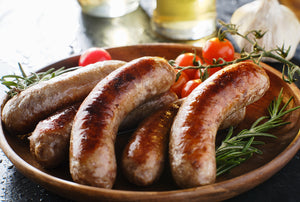A Butcher’s Guide to Bratwurst

Although hugely popular throughout the United States, bratwurst mystifies many Americans. What goes into bratwurst? How should it taste? There is no one answer to those questions. Bavaria alone, where these succulent sausages originated in the early Middle Ages, offers more than 40 versions. Different spice combinations go into each version. Spicy, sweet, earthy, smoky are common descriptors. Salt, pepper and nutmeg are common in the blander varieties, while spicier brats may contain allspice, caraway seed, cardamom, celery seed, ginger, lemon zest and marjoram.
“Our authentic smoked German Dakota Bratwurst, is a 50+ year old recipe that my grandfather used when he owned the market. We strive to use the highest quality ingredients in all of our brats, which are hand tied and smoked in house daily to perfection,” said Rochelle Holder, owner of Lakewood Meats & Sausage. She added, “We also offer fresh brats. Our sausage maker loves his job and it’s reflected in the quality and taste of our products. One bite is all it takes!”
What’s in a Name?
Bratwurst, in all its forms, is a sausage. “Wurst” means sausage in German. The first syllable’s origin is trickier, coming either from the modern German word for “fry” or from the Old High German term referencing the frugality of chopped meat. Indeed, sausage making began as a way of avoiding waste by making use of meat scraps from other dishes and that practice continues today. As an old-fashioned butcher shop, Lakewood Meats & Sausage uses only high-quality grade cuts of meats in their hand-tied sausage without any waste. They’re even a Certified Meat Processing Plant by the State of California.
All sausages begin as finely chopped fresh meat, combined with herbs and spices. Unlike other sausages that can be cooked up as patties, brats are stuffed into casings and tied off in links. Unlike precooked or dried sausages, brats are fresh links, requiring cooking.
How to Cook Bratwurst
Cooking methods are almost as diverse as the possible spice combinations. The key is to preserve the juices in the links, lest all those spice flavors escape. Many aficionados simmer brats in a shallow pool of water or beer for 15-20 minutes before grilling, broiling or frying for another five minutes—to crisp up the skin, without drying out the interior. Brats can also be boiled, baked or simmered in a Dutch oven with potatoes and onions. Visual clues aren’t the most reliable way of determining when brats are done. A pink interior may mean the sausage needs more cooking. Or the pink color may derive from additives contained in the links. The most reliable way of ensuring proper cooking is to use a meat thermometer, plunged into the center of the sausage. If it reads 160 to 165 degrees, start eating.
Health Concerns
Proper cooking techniques are essential to the healthy enjoyment of any fresh meat product but are not the only health concerns. Some critics point to the supposed health risks of any processed food. Yes, bratwurst is a processed food. So is homemade yogurt or a chopped salad. Technically, any method of changing the original physical or chemical composition of a foodstuff constitutes processing. Certainly, some food additives used as preservatives can be cause for concern, and their use must be balanced against the need to retard spoilage. Other additives, like spices and herbs, are not worrisome. Is a brat healthier than a hot dog? The answer depends on what preservatives each contains. A supermarket hot dog typically has significant levels of nitrites, more than the average brat link. Conversely, the brat may have more fat, while also providing more protein.
Selecting a reliable sausage maker, steeped in Old Country bratwurst traditions, is an excellent way of ensuring the healthiest options, the best nutrition, taste and texture in those succulent links. Add a hefty dollop of sauerkraut, drizzle with mustard and enjoy!
